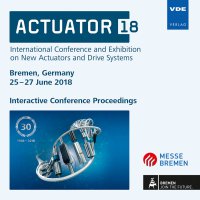Resistance Welding of NiTi Actuator Wires
Conference: ACTUATOR 2018 - 16th International Conference on New Actuators
06/25/2018 - 06/27/2018 at Bremen, Deutschland
Proceedings: ACTUATOR 2018
Pages: 5Language: englishTyp: PDF
Personal VDE Members are entitled to a 10% discount on this title
Authors:
Scholtes, D. (Universität des Saarlandes, Saarbrücken, Germany)
Zaeh, R. (Zentrum für Mechatronik und Automatisierungstechnik gGmbH, Saarbrücken, Germany & Hochschule für Technik und Wirtschaft Saarbrücken, Saarbrücken, Germany)
Schmidt, M.; Motzki, P.; Seelecke, S. (Universität des Saarlandes, Saarbrücken, Germany & Zentrum für Mechatronik und Automatisierungstechnik gGmbH, Saarbrücken, Germany)
Faupel, B. (Hochschule für Technik und Wirtschaft Saarbrücken, Saarbrücken, Germany)
Abstract:
Shape Memory Alloy (SMA) wires are a promising actuator technology, especially for designing light-weight and small systems, due to their high energy density. Their working principle is based on the fact that they contract when heated, which is typically done via an electrical current. State-of-the-art bonding technologies of SMA wires are crimping and clamping. Miniaturizing actuator systems and the complexity of the crimping process are two problematic fields for these technologies. Other possible methods are gluing, soldering and laser welding. None of these have established in the industrial field until now. To add another alternative to these joining mechanisms, the presented work focuses on resistance welding of NiTi actuator wires to stainless steel. The examined SMA wires have diameters of 25 to 100 µm. The welding parameters, the strength of the weld seam and the thermomechanical behavior of the welded samples are part of the investigation. The results show promising breaking loads of the welded samples and no obvious effect on the actuator behavior.


